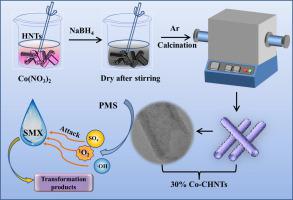Journal of Colloid and Interface Science ( IF 9.9 ) Pub Date : 2021-09-09 , DOI: 10.1016/j.jcis.2021.08.168 Zhuang He 1 , Huaisheng Wang 2 , Meng Li 3 , Ligang Feng 3 , Jianrui Niu 4 , Zaixing Li 4 , Xiuxiu Jia 5 , Guangzhi Hu 1

|
In this study, a new hollow nanotube material, 30% Co–CHNTs was prepared by the impregnation–chemical reduction–calcination method. This material can be used as a peroxymonosulfate (PMS) activator to catalyse the degradation of sulfamethoxazole (SMX). The best reaction conditions that correspond to the degradation rate of SMX, up to 97.5%, are as follows: the concentration of SMX is 10 mg L−1, the amount of catalyst is 0.20 g L−1, the dosage is 1.625 mM, and the solution pH is 6.00. X-ray photoelectron spectroscopy (XPS) and inductively coupled plasma optical emission spectrometry (ICP-OES) show that the calcined composites mainly stimulate an increase in the content of bivalent cobalt in PMS and reduce the leaching of cobalt ions after the reaction. Additionally, the 30% Co–CHNTs + PMS reaction system exhibits a reasonable SMX degradation rate in a natural organic matter solution and excellent stability after three repeated experiments. Furthermore, the possible degradation mechanism in the 30% Co–CHNTs + PMS reaction system was analysed through electron paramagnetic resonance (EPR) and free-radical capture experiments, and it was observed that the non-radical degradation of 1O2 plays a leading role in SMX degradation. Finally, according to the nine degradation intermediates detected by liquid chromatography-mass spectrometry (LC–MS), four possible SMX degradation routes were proposed. This study proved that a 30% Co–CHNTs heterogeneous catalyst is easily prepared, inexpensive, and environmentally friendly and has potential application in antibiotic wastewater treatment.
中文翻译:

无定形氧化钴修饰的埃洛石纳米管可有效降解过硫酸盐活化的磺胺甲恶唑
在这项研究中,通过浸渍-化学还原-煅烧方法制备了一种新型中空纳米管材料,30% Co-CHNTs。这种材料可用作过硫酸盐 (PMS) 活化剂,以催化磺胺甲恶唑 (SMX) 的降解。对应于SMX降解率高达97.5%的最佳反应条件如下:SMX浓度为10 mg L -1,催化剂用量为0.20 g L -1,用量为1.625 mM,溶液pH为6.00。X 射线光电子能谱 (XPS) 和电感耦合等离子体发射光谱 (ICP-OES) 表明,煅烧复合材料主要刺激 PMS 中二价钴含量的增加,并减少反应后钴离子的浸出。此外,30% Co-CHNTs + PMS 反应体系在天然有机物溶液中表现出合理的 SMX 降解率和经过 3 次重复实验后的优异稳定性。此外,通过电子顺磁共振(EPR)和自由基捕获实验分析了 30% Co-CHNTs + PMS 反应体系中可能的降解机制,观察到1 O 2的非自由基降解在 SMX 降解中起主导作用。最后,根据液相色谱-质谱 (LC-MS) 检测到的 9 种降解中间体,提出了四种可能的 SMX 降解路线。该研究证明,30% Co-CHNTs 多相催化剂制备容易、价格低廉、环境友好,在抗生素废水处理中具有潜在的应用价值。



























 京公网安备 11010802027423号
京公网安备 11010802027423号